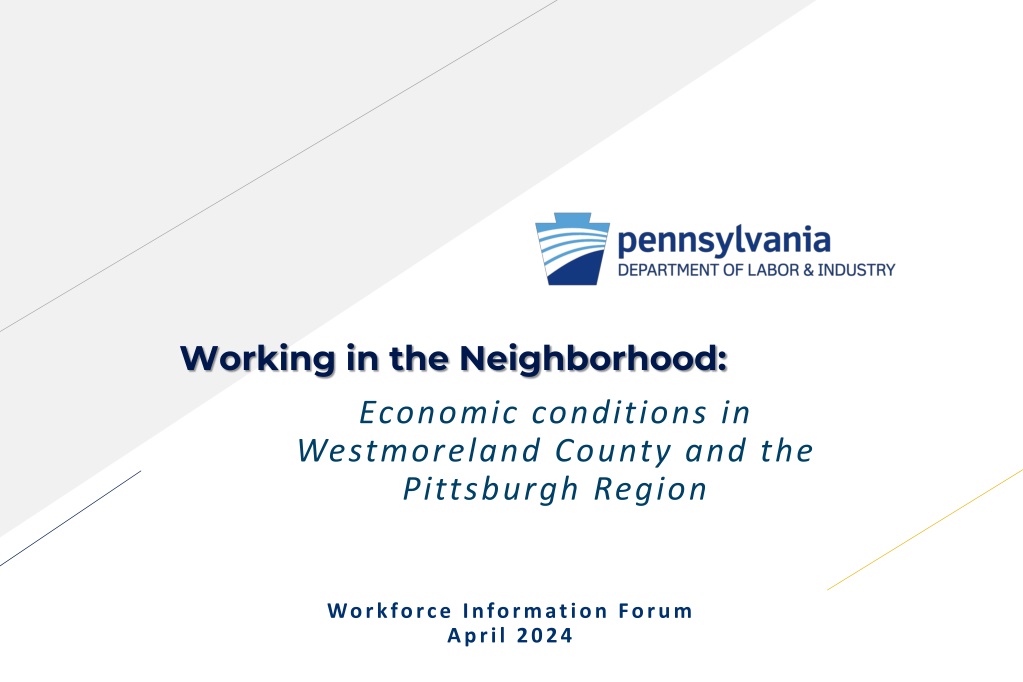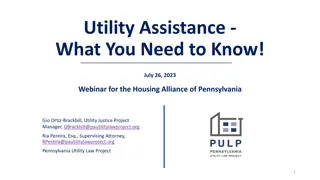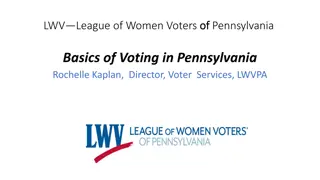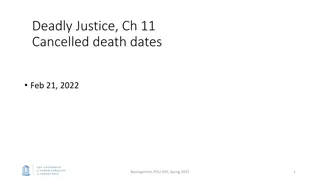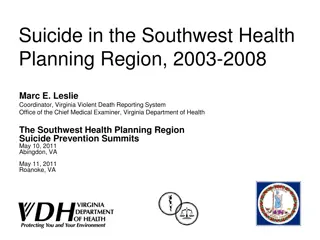Economic Trends in Southwest Pennsylvania Region
Explore economic conditions in Westmoreland County and the Pittsburgh region through workforce information forums, population changes, and unemployment rates. Discover how the Southwest Pennsylvania region has evolved over the decades in terms of population growth and labor market dynamics.
Download Presentation

Please find below an Image/Link to download the presentation.
The content on the website is provided AS IS for your information and personal use only. It may not be sold, licensed, or shared on other websites without obtaining consent from the author.If you encounter any issues during the download, it is possible that the publisher has removed the file from their server.
You are allowed to download the files provided on this website for personal or commercial use, subject to the condition that they are used lawfully. All files are the property of their respective owners.
The content on the website is provided AS IS for your information and personal use only. It may not be sold, licensed, or shared on other websites without obtaining consent from the author.
E N D
Presentation Transcript
Working in the Neighborhood: Economic conditions in Westmoreland County and the Pittsburgh Region Workforce Information Forum April 2024
Defining the Southwestern Pennsylvania Region For this discussion, define a region of Pennsylvania that includes the following counties: Allegheny Armstrong Beaver Butler Cambria Fayette Greene Indiana Lawrence Somerset Washington, and Westmoreland. The area highlighted in green includes the counties that makeup the Southwest Pennsylvania Region, including the Westmoreland-Fayette Development Area (WDA) within the greater Pittsburgh Metropolitan Statistical Area (MSA), at the center. Workforce 2
Percent change in population by decade, 1970-2020 Pennsylvania growth in resident population has been moderate, yet generally has outpaced the Southwest Pennsylvania Region over recent decades. 10.0 10.0 8.0 8.0 Pittsburgh MSA 3.4 3.4 6.0 6.0 2.4 4.0 4.0 0.5 0.6 0.1 2.0 2.0 0.0 0.0 -2.0 -2.0 -4.0 Pennsylvania -4.0 -1.5 -6.0 -3.1 -6.0 -4.0 -8.0 -6.8 -8.0 -10.0 -10.0 1970-1980 1980-1990 1990-2000 2000-2010 2010-2020 1970-1980 1980-1990 1990-2000 2000-2010 2010-2020 10.0 10.0 Westmoreland-Fayette WDA 8.0 8.0 Southwest PA Region 3.8 6.0 6.0 4.0 4.0 0.6 2.0 2.0 0.0 0.0 -2.0 -2.0 -0.4 -4.0 -4.0 -1.6 -2.8 -6.0 -3.3 -6.0 -3.2 -3.6 -6.5 -8.0 -8.0 -6.9 -10.0 -10.0 1970-1980 1980-1990 1990-2000 2000-2010 2010-2020 1970-1980 1980-1990 1990-2000 2000-2010 2010-2020 Note: Based on not seasonally adjusted annual average data, in thousands. Changes based on unrounded data. Source: Population Division, Bureau of the Census, U.S. Dept. of Commerce. 3
Percent change in population by county, 2020 - 2023 However, as of 2023, some counties makeup the Southwest Pennsylvania Region have increased their resident population since the most recent Census count in 2020. that Note: Percent change based on unrounded data; Annual Estimates of the Resident Population for Counties in Pennsylvania: April 1, 2020, to July 1, 2023 (CO-EST2023- POP-42). Source: Population Division, Bureau of the Census, U.S. Dept. of Commerce. 4
Unemployment Rates (%) by area, 1976-2023 19.0 18.0 2023: 17.0 16.0 Pennsylvania: 3.4% Southwest PA Region: 3.8% Pittsburgh MSA: 3.7% Westmoreland-Fayette WDA: 4.0% The weathered recent recessions (at least, since 1990) better than in decades. Region has 15.0 Unemployment Rate (%) 14.0 13.0 12.0 11.0 10.0 9.0 earlier 8.0 7.0 6.0 5.0 4.0 3.0 1988 1976 1978 1980 1982 1984 1986 1990 1992 1994 1996 1998 2000 2002 2004 2006 2008 2010 2012 2014 2016 2018 2020 2022 Southwest PA Region Pennsylvania Pittsburgh MSA Westmoreland-Fayette WDA Note: Based on annual average of unemployment rate data, in percent; midpoint of each year plotted. Grey bars indicate recession period. Source: Local Area Unemployment Statistics Program, Bureau of Labor Statistics, U.S. Dept. of Labor and Pennsylvania Dept. of Labor & Industry. 5
Percent change in nonfarm jobs for the Region, 1990 - 2019 Throughout the period, despite net job changes over business cycles, the long-term trend was movement away from goods-producing jobs, and towards gains in service-providing jobs. intervening Lawrence -7.5 Cambria -7.0 Armstrong -3.7 Somerset 0.5 Indiana 5.5 Allegheny 7.3 Manufacturing losses dominated throughout the Region, but gains were seen in construction, natural resources & mining in those counties heavily involved with Marcellus Shale and related activity (e.g., Beaver, Greene, Lawrence and Washington counties). Westmoreland 15.3 Beaver 18.4 Fayette 22.8 Greene 35.9 Washington 42.8 Butler 71.8 -20 Percent Change in Total Nonfarm Jobs, 1990 - 2019 -10 0 10 20 30 40 50 60 70 80 Note: Based on not seasonally adjusted annual average data, in 1000s; change based on unrounded data. Source: Current Employment Statistics Program, Bureau of Labor Statistics, U.S. Dept. of Labor; IHS Global Insight. Most counties posting net gains in total nonfarm jobs over the period saw gains in education & health services, and business services. professional & 6
Job growth rate within the Westmoreland-Fayette WDA by select industry sector, 1990 - 2019 Looking at the net nonfarm job change in Westmoreland- Fayette WDA over the period, for example, manufacturing fell by 7,200 (the second largest decline by percent of total loss among the industry sectors in these counties) from 1990 to 2019. 170 Rate of Job Growth 1990 = 100 160 150 140 130 120 110 100 90 80 At the same time, education & health services added nearly 12,000 jobs. Leisure & hospitality and professional & business services, combined, added an additional 12,600 jobs besides those added in education and healthcare. 70 60 1990 1992 1994 1996 1998 2000 2002 2004 2006 2008 2010 2012 2014 2016 2018 Westmoreland-Fayette WDA Total Nonfarm Jobs Westmoreland-Fayette WDA Manufacturing Westmoreland-Fayette WDA Education & Health Services Note: Based on total nonfarm not seasonally adjusted annual average data, in 1000s. Grey bars indicate recession period. Source: Current Employment Statistics Program, Bureau of Labor Statistics, U.S. Dept. of Labor; IHS Global Insight. 7
Percent change in total nonfarm jobs by county, 2019-2023 By county-level change in jobs since the peak of the last business cycle (2019), recovery from the recent downturn is still ongoing. Most growth throughout the Southwest PA Region to-date has been seen in the suburban counties surrounding Pittsburgh itself. Gains have varied among the Region s service-providing industry sectors, including professional & business services and financial activities. Other sectors posting job gains to-date include trade, transportation & utilities, and leisure & hospitality. Note: Totals based on not seasonally adjusted annual average data, and changes are based on unrounded data. Source: Current Employment Statistics Program, Bureau of Labor Statistics, U.S. Dept. of Labor; IHS Global Insight. 8
Details on the recent change in nonfarm jobs, 2019 versus 2023 Volume Change Percent Change 0.2 -2.5 -2.3 0.3 Area 2019 2023 Westmoreland-Fayette WDA Pittsburgh MSA Southwest PA Region Pennsylvania 183,800 1,190,200 1,160,600 1,343,700 1,312,700 6,066,000 6,086,300 184,100 300 -29,600 -31,000 20,300 For Westmoreland-Fayette Workforce Development Area (WDA): Largest volume change by industry since 2019 was within financial activities (up 18.0%), information (up 17.2%), manufacturing (up 3.5%) and professional & business services (up 2.6%). For the Southwest Pennsylvania Region: Faster than average growth versus the state over the period was seen mainly in trade, transportation & utilities, professional & business services, and financial activities, but overall, the WDA (and Southwest PA Region) grew slower than expected, when compared to Pennsylvania s overall growth in nonfarm jobs. Note: Totals based on not seasonally adjusted annual average data, and changes are based on unrounded data. Source: Current Employment Statistics Program, Bureau of Labor Statistics, U.S. Dept. of Labor; IHS Global Insight. 9
Details on the recent change in nonfarm jobs by domain, 2019 versus 2023 Goods-Producing Nonfarm Jobs Volume Change -100 -12,500 -14,400 -16,700 Percent Change -0.2 -7.7 -7.7 -1.9 For both the Region and state, the goods-producing domain continues to recover back to the 2019 level. Area 2019 2023 Westmoreland-Fayette WDA Pittsburgh MSA Southwest PA Region Pennsylvania 33,600 161,700 187,000 865,400 33,600 149,200 172,600 848,700 Nonfarm Westmoreland-Fayette WDA (as well as Pennsylvania overall) have exceeded their 2019 volumes among the service-providing domain. jobs in the Service-Providing Nonfarm Jobs Volume Change Percent Change 0.2 -1.7 -1.4 0.7 Area 2019 2023 Westmoreland-Fayette WDA Pittsburgh MSA Southwest PA Region Pennsylvania 150,200 1,028,500 1,011,400 1,156,700 1,140,100 5,200,600 5,237,500 150,500 400 -17,100 -16,600 36,900 Note: Totals based on not seasonally adjusted annual average data, and changes are based on unrounded data. Source: Current Employment Statistics Program, Bureau of Labor Statistics, U.S. Dept. of Labor; IHS Global Insight. 10
Change in labor force characteristics by area, 2019 versus 2023 Volume Change Percent Change 2019 2023 As of 2023, the Region s labor force also continues to recover since the downturn from the last business cycle peak in 2019. Labor Force Westmoreland-Fayette WDA Pittsburgh MSA Southwest PA Region Pennsylvania Employment 240,700 1,226,000 1,416,100 6,576,400 230,200 1,177,500 1,353,300 6,518,300 -10,600 -48,500 -62,700 -58,100 -4.4 -4.0 -4.4 -0.9 Westmoreland-Fayette WDA Pittsburgh MSA Southwest PA Region Pennsylvania Unemployment 229,100 1,173,200 1,353,500 6,291,700 221,000 1,134,100 1,302,200 6,295,600 -8,100 -39,100 -51,300 4,000 -3.6 -3.3 -3.8 0.1 Pennsylvania, meanwhile, has recovered to it s 2019 employment level. With ongoing recovery, the statewide unemployment rate also continues to decline, to record lows (since 1976). Westmoreland-Fayette WDA Pittsburgh MSA Southwest PA Region Pennsylvania Unemployment Rate (%) 11,600 52,800 62,600 284,800 9,200 43,400 51,200 222,700 -2,400 -9,400 -11,500 -62,100 -20.9 -17.8 -18.3 -21.8 Westmoreland-Fayette WDA Pittsburgh MSA Southwest PA Region Pennsylvania 4.8 4.3 4.4 4.3 4.0 3.7 3.8 3.4 -0.8 -0.6 -0.6 -0.9 --- --- --- --- Note: Totals based on not seasonally adjusted annual average data, and changes are based on unrounded data. Source: Local Area Unemployment Statistics Program, Bureau of Labor Statistics, U.S. Dept. of Labor; IHS Global Insight. 11
Technology-oriented occupational employment, as a percent of total occupational employment, by area Employment in technology-oriented occupations include those workers employed within the: computer and mathematical; architecture and engineering; life, physical and social sciences; and their related technicians, by occupational group. Occupations in these groups are codes by Standard Occupational Codes 15-0000, 17-0000, and 19-0000. Typical detailed occupations within these broad groups include, for example, computer systems analysts, software QA testers, civil and mechanical engineers, scientists in physics, chemistry, agriculture, and technicians in these and related fields. In Pennsylvania, these three broad occupational categories account for 5.6% of total occupational employment (325,000 out of 5.8 million employed, by occupation). Within the Southwest Pennsylvania Region, workers in technology-oriented occupations accounted for 69,600 out of 1.2 million employed (by occupation), or 5.8% of the total. Within the Pittsburgh MSA, workers in technology-oriented occupations accounted for 65,500 out of 1.1 million employed (by occupation), or 6.2% of the total. Note: Based on latest available data as of 2022, and changes are based on unrounded data. Source: Occupational Employment and Wage Statistics Program, CWIA, PA. Dept. of Labor & Industry. 12
Technology-oriented occupational employment, as a percent of total occupational employment, by county Within the Southwest PA Region by county, workers employed in technology-oriented occupations (as a share of workers in all occupations) varied from 7.3% of the total in Allegheny County to 2.0% of the total in Lawrence County. The technology-oriented workers (as a share of the workforce for all occupations) in counties within the Region--but outside of the Pittsburgh MSA--was found in Greene County, majority were found mainly in mining and geological engineering occupations. largest percentage of Note: Based on latest available data as of 2022. Totals based on not seasonally adjusted annual average data, and changes are based on unrounded data. Source: Occupational Employment and Wage Statistics Program, CWIA, PA. Dept. of Labor & Industry. where the 13
Projected percent change in technology- oriented occupational employment through 2030 The change in employment of Pennsylvania workers for all occupational groups is projected to be an increase of 7.6% statewide by 2030, from 5.9 million workers in 2020 to 6.4 million workers, an increase of 451,700. Within the occupations that include technology-oriented occupations (i.e., computer and mathematical sciences, architecture and engineering, and life, physical, and social sciences, plus related technicians), employment by occupation for these workers is projected to increase by 33,200 overall (up 10.1%) by 2030. The largest percentage change will be seen in Computer & Mathematical Occupations (up 13.4%), followed by Life, Physical & Social Science Occupations (up 7.9%), and Architecture & Engineering Occupations (5.9%). Within the Pittsburgh MSA, total occupational employment will rise by 7.0% by 2030. Employment within sectors that include technology-oriented occupations will increase by 6,000 (8.6%), mainly in computer & mathematical occupations. Within the Westmoreland-Fayette WDA, total occupational employment will rise by 3.3% by 2030. Employment within occupations that include technology-oriented occupations will increase by 400 (5.5%), againmainly in computer & mathematical occupations. Note: Based on latest available data as of 2022. Totals and changes based on unrounded data. Source: Occupational Employment and Wage Statistics Program, CWIA, PA. Dept. of Labor & Industry. 14
Forecast changes through 2030 Resident Population: For Westmoreland-Fayette WDA, the decline in population will total 12,600 (2.7%); Within the Pittsburgh MSA, the decline will total 23,400 (1.0%); and For the Southwest PA Region, resident pop. will decline by 37,600 (1.4%) from 2023. By age group, Working age (25-64) population falls by 5.2% for the WDA, 2.4% for the MSA, and 3.0% for the Region; Youth (24 and under) population falls by 8.7% for the WDA, 6.9% for the MSA, and 6.9% for the Region; and 65 and Older population rises by 8.2% for the WDA, 8.8% for the MSA, and 8.4% for the Region. Pennsylvania s resident population will decline by 17,200 (0.1%) through 2030. The comparable changes by age group for the state are: Declines of 1.7% and 3.7% in the working age and youth population, respectively; and An increase of 8.8% in those aged 65 and older over the period. Source: Population Division, Bureau of the Census, U.S. Dept. of Commerce.; IHS Global Insight. 15
Forecast changes through 2030 Labor Force: For Westmoreland-Fayette WDA, the labor force aged 16 and over is forecast to decline by 9,900 (4.3%) from 2023, and the unemployment rate will fall to 3.8% (a drop of 0.2 of a percentage point); Within the Pittsburgh MSA, the labor force will rise by 16,500 (1.4%) and the unemployment rate will stand at 4.8% (a rise of 0.9 of a percentage point); and Within the Southwest PA Region, the labor force will fall by 46,700 (3.5%), and the unemployment rate will stand at 3.7% (a decline of 0.1 of a percentage point). Nonfarm Jobs: For Westmoreland-Fayette WDA, the total number of nonfarm jobs by 2030 is forecast to total 181,900, a decline of 2,200 (1.2%) from 2023; Within the Pittsburgh MSA, total nonfarm jobs are projected to be 1.185 million, up 24,600 (2.1%); and Within the Southwest PA Region, total nonfarm jobs will increase by 14,100 (1.1%). Note: Based on annual average not seasonally adjusted data; region and county-level changes are based on the 10-year annual average percent change. Source: Population Division, Bureau of the Census, U.S. Dept. of Commerce.; Bureau of Labor Statistics, U.S. Dept. of Labor; IHS Global Insight; CWIA, Pennsylvania Dept. of Labor & Industry. 16
Summary Population change will act as a constraint on economic growth in the MSA and region, as the number of working age population (25-64) declines, fewer youth are available to enter the labor force, and those aged 65 and over will increase in number throughout the region. The Pittsburgh MSA will see higher job growth over time, versus the outlying counties that make up the larger Southwest Pennsylvania (12-county) region. However, the state will add service-providing jobs overall at a higher rate than either the MSA or the region over the period (particularly in professional & business services, and other services). Pittsburgh MSA job growth in construction, natural resources & mining, finance and education & health services, meanwhile, will outpace the state. Losses in manufacturing, trade and information for the MSA over the period will exceed those seen for Pennsylvania. Comprising over 6% of all employment (by occupation) within the Pittsburgh MSA, employment change in occupations that include technology-oriented occupations through 2030 will slightly exceed overall employment change for all occupations (i.e., nearly 9% for the technology sector versus 7% overall). Annual median wages within this sector exceeds $79,300, or $38 per hour in the Pittsburgh MSA. Note: Annual median wage and hourly wage are based on the 2020 weighted average within the sector, and 2080 hours per year. Source: Population Division, Bureau of the Census, U.S. Dept. of Commerce.; Bureau of Labor Statistics, U.S. Dept. of Labor; IHS Global Insight; CWIA, Pennsylvania Dept. of Labor & Industry. 17
Thank you! Questions?
